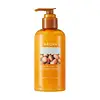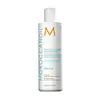What's inside
What's inside
 Key Ingredients
Key Ingredients

No key ingredients
 Benefits
Benefits

 Concerns
Concerns

 Ingredients Side-by-side
Ingredients Side-by-side

Water
Skin ConditioningPropylene Glycol
HumectantDimethicone
EmollientGlycerin
HumectantBehentrimonium Chloride
PreservativeBehentrimonium Methosulfate
Cetearyl Alcohol
EmollientBis(C13-15 Alkoxy) Pg-Amodimethicone
Cetyl Alcohol
EmollientParfum
MaskingBetaine
HumectantPCA
HumectantArgania Spinosa Kernel Oil
EmollientArginine
MaskingLactic Acid
BufferingCreatine
Skin ConditioningLavandula Angustifolia Extract
Skin ConditioningCitrus Aurantium Bergamia Leaf Extract
AstringentMentha Piperita Leaf Extract
Skin ConditioningFreesia Refracta Extract
Skin ConditioningChamomilla Recutita Flower Extract
MaskingRosmarinus Officinalis Leaf Extract
AntimicrobialPhenoxyethanol
PreservativeRosa Canina Fruit Oil
EmollientOenothera Biennis Oil
EmollientWater, Propylene Glycol, Dimethicone, Glycerin, Behentrimonium Chloride, Behentrimonium Methosulfate, Cetearyl Alcohol, Bis(C13-15 Alkoxy) Pg-Amodimethicone, Cetyl Alcohol, Parfum, Betaine, PCA, Argania Spinosa Kernel Oil, Arginine, Lactic Acid, Creatine, Lavandula Angustifolia Extract, Citrus Aurantium Bergamia Leaf Extract, Mentha Piperita Leaf Extract, Freesia Refracta Extract, Chamomilla Recutita Flower Extract, Rosmarinus Officinalis Leaf Extract, Phenoxyethanol, Rosa Canina Fruit Oil, Oenothera Biennis Oil
Water
Skin ConditioningCetearyl Alcohol
EmollientBehentrimonium Chloride
PreservativePPG-3 Benzyl Ether Myristate
EmollientStearamidopropyl Dimethylamine
EmulsifyingGlycerin
HumectantQuaternium-98
EmollientArgania Spinosa Kernel Oil
EmollientPersea Gratissima Oil
Skin ConditioningSimmondsia Chinensis Seed Oil
EmollientChamomilla Recutita Flower Extract
MaskingLavandula Angustifolia Flower Extract
CleansingRosmarinus Officinalis Leaf Extract
AntimicrobialHydrolyzed Vegetable Protein Pg-Propyl Silanetriol
Skin ConditioningSilk Amino Acids
HumectantHydrolyzed Keratin
HumectantKeratin Amino Acids
Skin ConditioningCellulose
AbsorbentHydroxyethylcellulose
Emulsion StabilisingPanthenol
Skin ConditioningCitric Acid
BufferingDimethicone
EmollientDimethiconol
EmollientLinoleamidopropyl Pg-Dimonium Chloride Phosphate Dimethicone
Polyquaternium-37
PPG-1 Trideceth-6
Skin ConditioningQuaternium-80
Caprylyl Glycol
EmollientPropylene Glycol
HumectantPropylene Glycol Dicaprylate/Dicaprate
EmollientAcrylates Copolymer
Disodium EDTA
Sodium PCA
HumectantParfum
MaskingGuar Hydroxypropyltrimonium Chloride
Skin ConditioningCinnamidopropyltrimonium Chloride
Polyacrylamidopropyltrimonium Chloride
Cetrimonium Chloride
AntimicrobialDehydroacetic Acid
PreservativeIsopropyl Alcohol
SolventSorbitan Oleate
EmulsifyingBenzyl Alcohol
PerfumingChlorphenesin
AntimicrobialPhenoxyethanol
PreservativePotassium Sorbate
PreservativeSodium Acetate
BufferingSodium Benzoate
MaskingCI 17200
Cosmetic ColorantCI 19140
Cosmetic ColorantAlpha-Isomethyl Ionone
PerfumingLinalool
PerfumingWater, Cetearyl Alcohol, Behentrimonium Chloride, PPG-3 Benzyl Ether Myristate, Stearamidopropyl Dimethylamine, Glycerin, Quaternium-98, Argania Spinosa Kernel Oil, Persea Gratissima Oil, Simmondsia Chinensis Seed Oil, Chamomilla Recutita Flower Extract, Lavandula Angustifolia Flower Extract, Rosmarinus Officinalis Leaf Extract, Hydrolyzed Vegetable Protein Pg-Propyl Silanetriol, Silk Amino Acids, Hydrolyzed Keratin, Keratin Amino Acids, Cellulose, Hydroxyethylcellulose, Panthenol, Citric Acid, Dimethicone, Dimethiconol, Linoleamidopropyl Pg-Dimonium Chloride Phosphate Dimethicone, Polyquaternium-37, PPG-1 Trideceth-6, Quaternium-80, Caprylyl Glycol, Propylene Glycol, Propylene Glycol Dicaprylate/Dicaprate, Acrylates Copolymer, Disodium EDTA, Sodium PCA, Parfum, Guar Hydroxypropyltrimonium Chloride, Cinnamidopropyltrimonium Chloride, Polyacrylamidopropyltrimonium Chloride, Cetrimonium Chloride, Dehydroacetic Acid, Isopropyl Alcohol, Sorbitan Oleate, Benzyl Alcohol, Chlorphenesin, Phenoxyethanol, Potassium Sorbate, Sodium Acetate, Sodium Benzoate, CI 17200, CI 19140, Alpha-Isomethyl Ionone, Linalool
 Reviews
Reviews

Ingredients Explained
These ingredients are found in both products.
Ingredients higher up in an ingredient list are typically present in a larger amount.
You may know this ingredient as argan oil. Argan Oil has antioxidant, hydrating, and soothing properties.
Studies have shown argan oil can help fight again radical damage from the sun. This makes it effective at preventing hyperpigmentation.
Large amounts of vitamin E found in argan oil helps the skin retain water. Argan oil also contains fatty acids such as linoleic acid, oleic acid, and palmitic acid. It is also a good source of lipids.
Another benefit of argan oil is skin-soothing. It can help reduce inflammation-related skin symptoms.
Argan Oil is effective at regulating sebum production in pores. This can make it effective at treating hormonal acne.
Traditionally, argan oil was used for its antibacterial and antifungal properties. However, argan oil contains fatty acids that may make it not fungal-acne safe.
Argan Trees are native to Morocco.
Learn more about Argania Spinosa Kernel OilThis ingredient is a preservative and often used for it's anti-static properties. You'll most likely see this ingredient in hair conditioners.
It does not cause irritation or sensitization in leave-on products at 1-5%.
Cetearyl alcohol is a mixture of two fatty alcohols: cetyl alcohol and stearyl alcohol. It is mainly used as an emulsifier. Emulsifiers help prevent the separation of oils and products. Due to its composition, it can also be used to thicken a product or help create foam.
Cetearyl alcohol is an emollient. Emollients help soothe and hydrate the skin by trapping moisture.
Studies show Cetearyl alcohol is non-toxic and non-irritating. The FDA allows products labeled "alcohol-free" to have fatty alcohols.
This ingredient is usually derived from plant oils such as palm, vegetable, or coconut oils. There is debate on whether this ingredient will cause acne.
Due to the fatty acid base, this ingredient may not be Malassezia folliculitis safe.
Learn more about Cetearyl AlcoholChamomilla Recutita Flower Extract comes from the Chamomile flower.
Chamomile is rich in antioxidants and has anti-inflammatory properties. Several compounds found in chamomile help with soothing, such as bisbolol.
Antioxidant components in chamomile make it an effective ingredient to help slow the signs of aging. Antioxidants help fight free-radical molecules, or molecules that may damage your skin.
Essential oils from chamomile have been found to improve wound healing due to its antimicrobial properties.
Ancient Greeks and Egyptians used Chamomile to treat skin redness and dryness. Chamomile has also been used to help treat stomach issues.
Learn more about Chamomilla Recutita Flower ExtractDimethicone is a type of synthetic silicone created from natural materials such as quartz.
What it does:
Dimethicone comes in different viscosities:
Depending on the viscosity, dimethicone has different properties.
Ingredients lists don't always show which type is used, so we recommend reaching out to the brand if you have questions about the viscosity.
This ingredient is unlikely to cause irritation because it does not get absorbed into skin. However, people with silicone allergies should be careful about using this ingredient.
Note: Dimethicone may contribute to pilling. This is because it is not oil or water soluble, so pilling may occur when layered with products. When mixed with heavy oils in a formula, the outcome is also quite greasy.
Learn more about DimethiconeGlycerin is already naturally found in your skin. It helps moisturize and protect your skin.
A study from 2016 found glycerin to be more effective as a humectant than AHAs and hyaluronic acid.
As a humectant, it helps the skin stay hydrated by pulling moisture to your skin. The low molecular weight of glycerin allows it to pull moisture into the deeper layers of your skin.
Hydrated skin improves your skin barrier; Your skin barrier helps protect against irritants and bacteria.
Glycerin has also been found to have antimicrobial and antiviral properties. Due to these properties, glycerin is often used in wound and burn treatments.
In cosmetics, glycerin is usually derived from plants such as soybean or palm. However, it can also be sourced from animals, such as tallow or animal fat.
This ingredient is organic, colorless, odorless, and non-toxic.
Glycerin is the name for this ingredient in American English. British English uses Glycerol/Glycerine.
Learn more about GlycerinParfum is a catch-all term for an ingredient or more that is used to give a scent to products.
Also called "fragrance", this ingredient can be a blend of hundreds of chemicals or plant oils. This means every product with "fragrance" or "parfum" in the ingredients list is a different mixture.
For instance, Habanolide is a proprietary trade name for a specific aroma chemical. When used as a fragrance ingredient in cosmetics, most aroma chemicals fall under the broad labeling category of “FRAGRANCE” or “PARFUM” according to EU and US regulations.
The term 'parfum' or 'fragrance' is not regulated in many countries. In many cases, it is up to the brand to define this term.
For instance, many brands choose to label themselves as "fragrance-free" because they are not using synthetic fragrances. However, their products may still contain ingredients such as essential oils that are considered a fragrance by INCI standards.
One example is Calendula flower extract. Calendula is an essential oil that still imparts a scent or 'fragrance'.
Depending on the blend, the ingredients in the mixture can cause allergies and sensitivities on the skin. Some ingredients that are known EU allergens include linalool and citronellol.
Parfum can also be used to mask or cover an unpleasant scent.
The bottom line is: not all fragrances/parfum/ingredients are created equally. If you are worried about fragrances, we recommend taking a closer look at an ingredient. And of course, we always recommend speaking with a professional.
Learn more about ParfumPhenoxyethanol is a preservative that has germicide, antimicrobial, and aromatic properties. Studies show that phenoxyethanol can prevent microbial growth. By itself, it has a scent that is similar to that of a rose.
It's often used in formulations along with Caprylyl Glycol to preserve the shelf life of products.
Propylene Glycol is an odorless, colorless liquid. As a humectant, it helps skin retain moisture. It also aids in delivering active ingredients.
Another role of this ingredient is preventing a product from melting or freezing. Propylene glycol also adds antimicrobrial properties to a product, elongating product lifespan.
This ingredient is considered an organic alcohol and commonly added into both cosmetics and foods.
Those with sensitive skin or conditions may develop a rash when using this ingredient.
Learn more about Propylene GlycolRosmarinus Officinalis Leaf Extract comes from rosemary. Rosemary is native to the Mediterranean.
While Rosmarinus Officinalis Leaf Oil can be volatile due to its fragrant properties, the fragrance components are usually removed in the leaf extract.
Rosemary Leaf Extract contains many antioxidants such as rosmarinic acid and caffeic acid. Rosemarinic acid, a compound found in rosemary leaf, has been found to help soothe skin conditions such as eczema and acne.
Learn more about Rosmarinus Officinalis Leaf ExtractWater. It's the most common cosmetic ingredient of all. You'll usually see it at the top of ingredient lists, meaning that it makes up the largest part of the product.
So why is it so popular? Water most often acts as a solvent - this means that it helps dissolve other ingredients into the formulation.
You'll also recognize water as that liquid we all need to stay alive. If you see this, drink a glass of water. Stay hydrated!
Learn more about Water